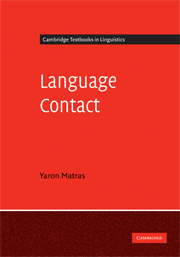Book contents
- Frontmatter
- Contents
- List of figures
- Preface
- List of abbreviations
- 1 Introduction
- 2 An emerging multilingual repertoire
- 3 Societal multilingualism
- 4 Acquiring and maintaining a bilingual repertoire
- 5 Crossing the boundaries: codeswitching in conversation
- 6 The replication of linguistic ‘matter’
- 7 Lexical borrowing
- 8 Grammatical and phonological borrowing
- 9 Converging structures: pattern replication
- 10 Contact languages
- 11 Outlook
- Notes
- References
- Author index
- Language index
- Subject index
3 - Societal multilingualism
Published online by Cambridge University Press: 05 June 2012
- Frontmatter
- Contents
- List of figures
- Preface
- List of abbreviations
- 1 Introduction
- 2 An emerging multilingual repertoire
- 3 Societal multilingualism
- 4 Acquiring and maintaining a bilingual repertoire
- 5 Crossing the boundaries: codeswitching in conversation
- 6 The replication of linguistic ‘matter’
- 7 Lexical borrowing
- 8 Grammatical and phonological borrowing
- 9 Converging structures: pattern replication
- 10 Contact languages
- 11 Outlook
- Notes
- References
- Author index
- Language index
- Subject index
Summary
Linguistic repertoires and social activities: a micro-level approach
In Chapter 2 we observed how a multilingual child's linguistic socialisation involved the acquisition of the skill to select structures from the linguistic repertoire that match the expectations of his adult interlocutors. Already at an early stage in the acquisition process, individual words within the repertoire began to crystallise into coherent sets as a result of their association with the child's three principal adult interlocutors: the German-speaking mother, the Hebrew-speaking father, and the English-speaking child-minder. As the child's experience in social interaction grew, so did the inventory of cues associated with each set of structures: a video in Hebrew, a family friend who speaks German, a shop where English is spoken and so on. This association between a set of interaction cues and a set of words leads to the gradual build-up of selection rules and mental demarcation lines among components within the linguistic repertoire. Later on, the child will learn to refer to these components as different ‘languages’; but the separation of languages starts off as a differentiated mapping of sets of linguistic structures onto sets of social activities. This is the core of an individual's – or micro-level – management of a multilingual repertoire.
- Type
- Chapter
- Information
- Language Contact , pp. 41 - 60Publisher: Cambridge University PressPrint publication year: 2009

